
Viji Kurup, M.D. (right), discusses the effective use of podcasts in teaching as Janak Chandrasoma, M.D. (left), and Larry Chu, M.D., listen.
Education has changed greatly since most anesthesiology faculty members were students, but many of them continue to use teaching methods from their youth that do not succeed with millennials studying medicine today. To their credit, faculty members are trying to adapt by using digital formats, such as videos and podcasts.
A Tuesday session, “Using Podcasts for Resident Education — The Process and Possibilities,” focused on the education formats most preferred by millennials, how combinations of education formats produce the best results and how to record an effective podcast.
“The way millennials are learning today is not the way we learned ourselves. If we think they are learning from textbooks, we are wrong,” said Larry Chu M.D., Professor of Anesthesiology, Perioperative and Pain Medicine at Stanford University Medical School. “They are wired differently and are very knowledgeable power users of tech. The millennial generation is mobile and constantly connected to the internet.”
Studies show that anesthesia residents are heavy users of tablet devices and smartphones. A 2014 survey showed that 60 percent of residents agreed that “a mobile device (e.g., iPad) would enhance my ability to learn in a meaningful way,” and more than 40 percent agree strongly that “mobile devices (e.g., iPads) are underutilized in anesthesia education.”
Studies also show that the preferred medium for learning new clinical procedures is about the same for both intraoperative teaching and videos, Dr. Chu said. The media they use most are Facebook, YouTube and Twitter.
Presenting the viewpoint of millennials was Janak Chandrasoma, M.D., Assistant Professor of Clinical Anesthesiology at the University of Southern California Keck School of Medicine. For many years, millennials have been swiping pages on digital screens, not turning pages in a book, he said.
“For millennials, studying is an inherently different process than it was for you. That is why they play with phones during a lecture. They are not capable of going through a textbook or curling up with a novel,” he said.
Instead, they prefer to learn from podcasts they can listen to as they drive, work out or cook a meal.
Viji Kurup, M.D., Associate Professor in the Department of Anesthesiology at Yale University, backed up what Dr. Chandrasoma said by reviewing information collected by the National Endowment for the Arts. It showed that more than half of young people do no reading for pleasure. In addition, anesthesia faculty members struggle to develop alternative teaching methods.
“Faculty are under a lot of stress. They have to come up with efficient ways to teach. They have to restructure didactics,” she said, and she reviewed research, which showed that blended learning was most effective.
Blended learning is a combination of online and face-to-face instruction. Studies show that low-order cognitive skills are learned better through online lectures while high-order cognitive skills are better learned in traditional lectures.
Dr. Chandrasoma then demonstrated how to record an effective podcast using GarageBand, an Apple application. A comparable PC program is Audacity. Both are free. He suggested that using a microphone in a quiet area with music and sound effects improve the quality of the recording, and those are available in GarageBand.
Dr. Kurup found that sending podcasts to provide background material to residents helped them be better prepared for team sessions in class.
“It is a very interactive exercise,” she said. “They need the basic information ahead of time, and they learn it because of peer pressure. They want to be part of the team and bring something to the table.”
She also reviewed studies indicating that people learn better when they are repeatedly exposed to new materials, and then testing themselves on it immediately after a teaching session.
Return to Archive Index